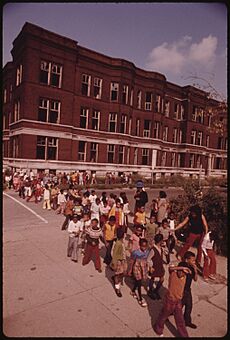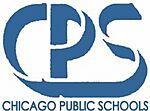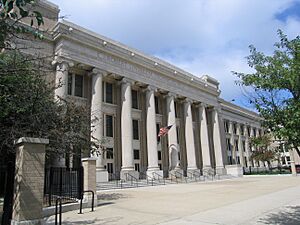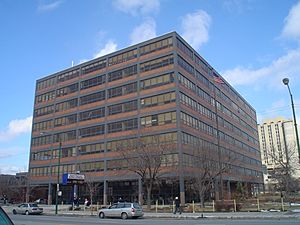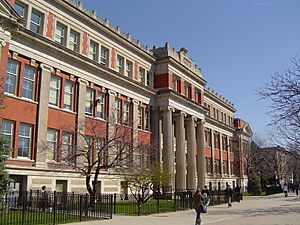Chicago Public Schools facts for kids
Quick facts for kids City of Chicago School District #299 |
|
|---|---|
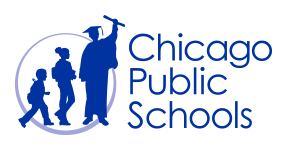 |
|
| Address | |
| 42 West Madison Street Chicago, Illinois, Cook County, 60602 United States |
|
| Coordinates | 41°52′56″N 87°37′44″W / 41.88212740°N 87.62883500°W |
| District information | |
| Type | Public School District |
| Motto | For every child, In every neighborhood. |
| Grades | Pre-K–12th |
| Established | January 5, 1837 |
| Superintendent | Macquline King (interim) |
| School board | Chicago Board of Education |
| Chair of the board | Sean Harden |
| Accreditation | AdvancED |
| Schools | 634 (2023–24) |
| Budget | US$8.49 billion (2023–24) |
| District ID | 1709930 |
| Students and staff | |
| Students | 323,251 (2023–24) |
| Teachers | 23,979 (2023–24) |
| Staff | 44,074 (2023–24) |
| Student-teacher ratio | 15.84 (2019–20) |
| Athletic conference | Chicago Public League |
Chicago Public Schools (CPS), also known as City of Chicago School District #299, is a large school district in Chicago, Illinois. It is the fourth-largest school district in the United States. For the 2023–24 school year, CPS managed 634 schools. This included 477 elementary schools and 157 high schools. Most of these schools (514) were run by the district itself. There were also 111 charter schools, 7 contract schools, and 2 SAFE schools.
CPS serves 323,251 students. Most students go to a school based on where they live. However, some schools, like charter, magnet, and selective enrollment schools, have different rules for admission. In the 2022-23 school year, 84% of students graduated from high school.
CPS calls its main leader the "chief executive officer" instead of a "superintendent." This person has similar jobs to a superintendent in other school districts. In the 2019–20 school year, there were about 15.84 students for every teacher. In 2020–21, about 46.7% of CPS students were Latino and 35.8% were African-American. Many students (63.8%) came from families with lower incomes. Also, 18.6% of students were learning English. In 2023, CPS spent about $18,287 per student.
Chicago Public Schools has shown great improvement in test scores. Students learned faster than those in 96% of other school districts across the country. In 2020, the graduation rate was the highest it had ever been.
Contents
History of Chicago Schools
Chicago started as a trading post in the 1800s. It took many years to create a citywide school system with enough money and teachers. By 1848, city leaders knew Chicago needed a public school system. The mayor at the time, James Hutchinson Woodworth, wanted high standards for schools. He believed this would help attract good citizens to Chicago.
In 1922, the school board changed a rule about libraries. They voted to give "Race children" (meaning Black children) the same access to libraries as white children. However, schools themselves remained separated by race.
In 1937, a polio outbreak caused schools to close for three weeks. The superintendent, William Johnson, and assistant superintendent, Minnie Fallon, found a way to teach elementary students at home. They used radio broadcasts for lessons. This was the first time radio was used on a large scale for distance learning.
School Funding Challenges
By the 1960s, schools in Chicago and Illinois faced money problems. Schools got most of their money from property taxes. This meant wealthy areas had better-funded schools, while poorer areas had less money for their schools. This problem was made worse by practices like redlining, which separated communities by wealth and race.
In 1973, a new plan called the Illinois Resource Equalizer Formula tried to share tax money more fairly. But some wealthy families did not want their taxes to go to other communities, especially those that were mostly Black. This plan was stopped in the late 1980s. Money problems for schools still exist in Chicago and Illinois today.
Changes and School Closures
From 2001 to 2009, CPS closed many elementary and high schools. This happened because schools had too few students or were not performing well. Researchers found that most students who moved to new schools after closures did not improve their grades.
This led to a plan called Renaissance 2010. This plan aimed to close public schools and open more charter schools. These new schools focused on different ways of learning. During this time, over 80 schools were closed. The plan also aimed to open 100 charter schools.
In 2013, CPS announced it might close nearly 200 schools. Many parents, students, teachers, and community members protested this idea. They worried about how it would affect minority communities. They also worried about schools becoming too crowded and students having to travel further. On May 22, 2013, the school board voted to close 50 public schools. Most of these schools were in poorer, mostly Black neighborhoods. Over 88% of the students affected by these closures were African American.
Student and Teacher Protests
In 2013, the mayor of Chicago decided to close 54 public schools. This included 53 elementary schools and one high school. The mayor said these closures were needed because the city had a large money problem and schools had too few students. The schools to be closed were mainly on Chicago's South and West sides, serving mostly African-American students.
These decisions made many communities and the Chicago Teachers Union (CTU) very upset. They felt it was unfair. As a result, the CTU and other groups organized protests. In May 2013, hundreds of protesters marched against the school closings. They held rallies, marches, and sit-ins. Some protesters blocked traffic and were arrested, but all protests were peaceful.
Teacher Strikes in CPS
Teachers in Chicago have gone on strike many times to ask for better pay, smaller class sizes, and more support for schools.
- The first strike by the teachers union was in May 1969 and lasted two days.
- In January 1971, a four-day strike led to an 8% pay raise for teachers.
- Another strike in January 1973 lasted twelve days. Teachers wanted higher salaries and smaller classes.
- In September 1975, teachers went on strike for eleven days. They wanted to get back teaching and office jobs that had been cut.
Strikes in the 1980s
- In February 1980, a ten-day strike happened because teachers wanted to be paid for days worked during a money crisis.
- In 1983, teachers went on a fifteen-day strike. They asked for a 10% pay raise. The strike ended with teachers getting a 5% raise.
- A ten-day strike in November 1984 resulted in a 4.5% raise.
- In 1985, teachers had a two-day walkout.
- The longest strike in this period was nineteen days, from September to October 1987.
Recent Teacher Strikes
- In September 2012, CPS teachers went on a nine-day strike. This was the first time they had stopped working in 25 years. Teachers protested about pay, how they were evaluated, and general concerns about the school system.
- On October 17, 2019, the Chicago Teachers Union went on another strike that lasted 11 days. After talks with the mayor, teachers won smaller class sizes and more support staff. Students also had five of the strike days added to their school year.
Student Population in CPS
For the 2018–2019 school year, CPS had 361,314 students. This included students from preschool to 12th grade. The student body was made up of:
- 46.7% Hispanic
- 36.6% African-American
- 10.5% White
- 4.1% Asian/Pacific Islander
- 1.2% Multi-Racial
- 0.3% Native American
- 0.2% Hawaiian/Pacific Islander
In 2012, research showed that Chicago Public Schools were very separated by race and ethnicity. This was because most students went to schools close to their homes. In the 1970s, the number of Mexican students in CPS grew. By the 1980s, the number of non-Hispanic White students went down. At the same time, the number of Hispanic/Latino and African-American students increased.
Types of Schools in CPS

CPS has many types of schools: elementary, middle, and high schools. Most schools have attendance boundaries. This means students must live in a certain area to go to that school. However, some schools can accept students from outside their area if they have space or special programs.
Full magnet schools are open to students from all over the city. Students usually need to meet high academic standards to get in. Magnet schools offer many different programs. These can focus on things like fine arts, math, science, or technology (STEM). STEM Magnet Academy was the first elementary school in Illinois to focus on STEM. The Chicago High School for the Arts (ChiArts) is the only high school in the system that requires an audition. It focuses on performing and visual arts.
Selective Enrollment Schools
CPS has special schools that students must apply and be accepted into. These are called selective enrollment schools.
Elementary Selective Schools
There are two types of selective elementary school programs:
- Regional gifted centers: These schools focus on specific areas like math and science. Students take a special test, similar to an IQ test, to get in.
- Classical schools: These schools focus on a wide range of subjects, like a liberal arts approach. They require a different type of test for admission.
High School Selective Enrollment
CPS has eleven selective enrollment high schools. Some examples include Walter Payton College Prep and Lane Tech College Prep. To get into these schools, students earn points based on:
- Their score on the CPS High School Admissions Test (450 points). This test covers reading and math.
- Their 7th-grade grades (450 points). For example, an A grade gives 112.5 points.
Getting into these schools is very competitive. Students rank their top 6 choices. The higher a school is on their list, the better their chances if they have enough points.
Other High School Choices
Besides selective enrollment schools, students have other high school options:
- Military academies: These schools partner with Junior Reserve Officers' Training Corps programs. There are six public military academies, such as Air Force Academy High School and Phoenix Military Academy.
- Career academies: These schools help students prepare for specific jobs. They have special workshops and labs for fields like business, construction, health, and performing arts. Examples include Dunbar Vocational Career Academy.
Charter Schools in Chicago
Chicago has many charter schools. In the 2017–2018 school year, there were 122 charter schools. Different groups run these schools. For example, Frazier Preparatory Academy is run by an independent board.
The Noble Network of Charter Schools runs eighteen high schools. These schools get most of their money from the same tax sources as regular CPS schools. Charter schools in Chicago often receive a bit less public money than traditional schools. Some studies show that students in charter schools perform similarly to those in traditional CPS schools.
However, a 2014 study found that Chicago charter schools sometimes performed worse than traditional schools in reading and math. This study also noted that charter schools were less likely to have a mix of different races and ethnicities. Despite this, in 2015, the Noble Network of Charter Schools was named a top-performing charter system and received an award.
How CPS is Managed
The way Chicago Public Schools is run changed when the mayor of Chicago gained more control. Unlike most school districts in Illinois, where local boards are elected, the mayor of Chicago appoints the CPS school board. This board then appoints the Chief Executive Officer. However, the school board will slowly change to have all elected members by 2027.
CPS headquarters are located at 42 West Madison Street in the Chicago Loop.
Chief Executive Officer (CEO)
The CEO is the main leader of CPS. The mayor of Chicago chooses this person. The current CEO is Pedro Martinez. Before 1995, this position was called "superintendent."
Chicago Board of Education
The school board, called the Chicago Board of Education, helps run CPS. The mayor of Chicago currently appoints its members. Between 2024 and 2027, the board will gradually become fully elected. The board has been around since 1837. The current president of the Chicago Board of Education is Sean Harden.
Local School Councils
In 1988, a law created Local School Councils. These councils help manage individual schools.
School Performance
A study in 2006 looked at how many CPS freshmen would earn a bachelor's degree by age 25. It found that 6 out of every 100 CPS freshmen would achieve this. For Black or Latino men, it was 3 out of 100. Of CPS students who went to college, 35% earned their bachelor's degree within six years. This was lower than the national average of 64%.
Chicago has had a history of students dropping out of high school. For 30 years, about half of students did not graduate. CPS has been criticized for making its graduation numbers look better than they are. However, real graduation rates did improve slightly, from 48% in 1991 to 54% in 2004.
In 1987, the U.S. Education Secretary said Chicago Public Schools was the worst in the nation. But a 2011 report from the University of Chicago looked at 30 years of changes in CPS. It found some important things:
- Graduation rates improved a lot, and high school test scores went up.
- Math scores improved in elementary and middle grades. Reading scores stayed about the same.
- Gaps in achievement between different racial groups grew. White students made more progress than Latino students, and African American students fell behind.
- Even with progress, most CPS students still need to improve their academic skills to be ready for college.
School Funding and Management Issues
The state government of Illinois required Chicago Public Schools to move money from education to worker pensions. CPS is the only district in the state that had to do this. In 2017, CPS filed a lawsuit to ask the courts to change these rules.
There have been issues with how money is managed within CPS. In 2014, the Office of the Inspector General received over 1300 complaints about problems. Their report found that issues with money and rules were still a problem. This included large amounts of school money being misused, and people not following rules about student transfers or applications. In one case, almost $900,000 was misused by several employees. CPS stated they are working to fix these problems.
In 2015, a former CEO of Chicago Public Schools faced issues related to a contract with a company she had worked for. She later resigned. The Chicago Board of Education filed a lawsuit against her and others involved. In 2016, the Inspector General's office again received many complaints about financial issues and rule-breaking within CPS.
See also
 In Spanish: Escuelas Públicas de Chicago para niños
In Spanish: Escuelas Públicas de Chicago para niños
- List of schools in Chicago Public Schools
- Chicago Public High School League
- Communities In Schools of Chicago
- Middle School Cadet Corps
- Renaissance 2010


